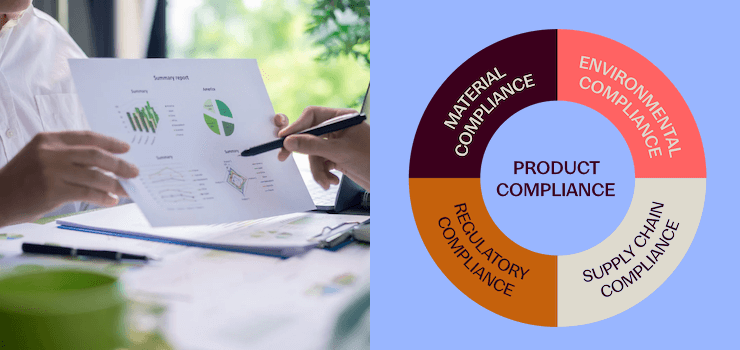Whether in electric vehicles, industrial machinery, or consumer electronics, batteries are at the heart of today’s manufacturing value chains. For producers, suppliers, and recyclers, they represent both a business opportunity and a regulatory challenge. Rising expectations around sustainability, material traceability, and safe end-of-life management are reshaping how companies operate.
The EU Battery Regulation (Regulation (EU) 2023/1542) responds to these challenges with a comprehensive framework designed to increase transparency and reduce environmental impact. For businesses across automotive, electronics, and related industries, the regulation is not only a compliance obligation but also a catalyst for digital transformation and long-term competitiveness in a circular economy.
Table of Contents
- EU Battery Regulation: Key Facts at a Glance
- What Does the EU Battery Regulation Cover?
- Spotlight: What Is The EU Battery Passport?
- Discover the Value of Digital Product Passports
- Timeline & Compliance Milestones: When Does What Apply?
- What Companies Must Do Now
- IPOINT: Enabling Battery Regulation Compliance with Proven Expertise
- Preparing for a New Era of Battery Compliance
EU Battery Regulation: Key Facts at a Glance |
|
What Does the EU Battery Regulation Cover?
The EU Battery Regulation (Regulation (EU) 2023/1542) entered into force on 17 August 2023, replacing the long-standing EU Battery Directive. Unlike the directive, which allowed room for national interpretations, the regulation introduces binding and uniform requirements across all EU member states.
Its scope covers the entire battery life cycle, from design and production to use and end-of-life management. It regulates every major category, including portable batteries, industrial batteries with a capacity greater than 2 kWh, electric vehicle (EV) batteries, stationary energy storage systems (SBESS), and light means of transport (LMT) batteries.
The key objectives are clear: minimize environmental impact, ensure traceability and due diligence, and improve data transparency to foster a circular economy. By embedding strict reporting and sustainability requirements, the regulation sets a new benchmark for safety, performance, and durability in the European market.
The regulation applies to a wide range of stakeholders in the battery supply chain, including:
- Manufacturers of batteries and battery-powered products
- Importers bringing batteries into the EU market
- Distributors placing batteries in different sales channels
- Recyclers and waste operators handling end-of-life batteries
- Other economic operators responsible for ensuring compliance
- Extended Producer Responsibility (EPR) & End-of-Life Vehicles
Spotlight: What Is The EU Battery Passport?
The Battery Passport is a digital product record that makes battery-related data accessible throughout the supply chain. Its goal is to ensure full transparency on how batteries are produced, used, and managed at the end-of-life stage. The introduction of the Battery Passport is a central innovation of the EU Battery Regulation.
The passport will be mandatory for industrial batteries with a capacity greater than 2 kWh, electric vehicle (EV) batteries, and light means of transport (LMT) batteries. For these categories, companies must provide standardized digital information that can be easily shared across stakeholders.
Each Battery Passport must include:
- Carbon footprint and recycled material content
- Material origin and supply chain data
- Technical specifications, condition, and repairability
Importantly, the Battery Passport is closely linked to the EU’s Digital Product Passport (DPP) initiative, which aims to provide consistent product information across industries and support the transition to a circular economy.
Discover the Value of Digital Product Passports
.png?width=579&height=344&name=EU_Battery_Regulation_NEW(1).png)
Find out how digital product passports enable transparency and support circular economy goals. Learn how IPOINT contributes to their development.
Timeline & Compliance Milestones: When Does What Apply?
The EU Battery Regulation (EU 2023/1542) is being phased in with staggered deadlines to enable companies to adapt gradually to its requirements:
| 28 July 2023 |
The Regulation was published in the Official Journal of the European Union. |
| 17 August 2023 | The Regulation officially entered into force across the EU. |
| 18 February 2024 | The Regulation’s core provisions became mandatory, though some Battery Directive measures remain in effect until 2025. |
| 18 August 2024 | Safety, performance, durability requirements, CE marking, conformity procedures, and obligations for economic operators became mandatory for industrial (> 2 kWh), EV, LMT, and stationary energy storage batteries. |
| 18 February 2025 | Carbon footprint declarations became mandatory for electric vehicle batteries. |
| 18 August 2025 | The old Battery Directive was fully repealed, making the new Regulation the sole applicable legal framework for batteries in the EU. |
| 18 February 2026 | Carbon footprint requirements started to apply to rechargeable industrial batteries with a capacity greater than 2 kWh. |
| 18 February 2027 | The Battery Passport became mandatory for industrial batteries (> 2 kWh), EV batteries, and LMT batteries; removability and replaceability requirements also took effect. |
| 18 August 2027 | Due diligence obligations for battery supply chains were postponed to this date as part of the EU’s Omnibus IV simplification package. |
| 18 August 2028 | Requirements for recycled material content in industrial, EV, and starter batteries, along with updated conformity procedures, became mandatory. |
In addition, the regulation foresees the adoption of delegated and implementing acts to define details on labeling, technical documentation, and other compliance obligations. These acts will gradually shape the practical implementation of the regulation and specify further requirements for companies.
What Companies Must Do Now
The EU Battery Regulation places far-reaching responsibilities on manufacturers, suppliers, and recyclers. To stay compliant and avoid disruption, businesses should begin preparations without delay. Key actions include:
- Assess your battery portfolio: Map which product categories fall under the regulation and identify specific requirements and reporting obligations.
- Set up robust data collection systems: Capture information on carbon footprint, material origin, and recycling content across the entire supply chain.
- Engage suppliers early: Establish transparent reporting processes and ensure partners can provide the required data on time.
- Strengthen collaboration: Build structures for cross-functional cooperation between compliance, procurement, IT, and sustainability teams.
- Evaluate digital solutions: Use scalable platforms to manage reporting complexity, support audit readiness, and align with upcoming initiatives like the Digital Product Passport.
IPOINT: Enabling Battery Regulation Compliance with Proven Expertise
For companies navigating the EU Battery Regulation, digital infrastructure is no longer optional. Extensive reporting and traceability obligations demand scalable, audit-ready solutions that bring together compliance, sustainability, and supply chain data.
Preparing for a New Era of Battery Compliance
The EU Battery Regulation is reshaping how companies in automotive, electronics, and related industries design, source, and manage batteries. For businesses across the supply chain, the regulation is not only a compliance obligation but also a chance to strengthen sustainability performance and gain a competitive edge in the global market.
Digital solutions from IPOINT provide the infrastructure needed to manage complex reporting, ensure audit readiness, and align with circular economy goals. By acting now, you can turn regulatory pressure into an opportunity for long-term resilience and growth. Get in touch with our experts and find out how IPOINT solutions can help you navigate the EU Battery Regulation with confidence.
Frequently Asked Questions
What is the EU Battery Regulation and whom does it affect?
What is the Battery Passport and when is it mandatory?
The Battery Passport is a digital product record that provides transparent data on battery composition, carbon footprint, and lifecycle performance. It becomes mandatory in 2027 for industrial batteries above 2 kWh, electric vehicle (EV) batteries, and light means of transport (LMT) batteries.
What types of batteries are covered?
The regulation applies to all battery categories, including portable batteries, industrial batteries, EV batteries, stationary energy storage systems (SBESS), and LMT batteries. The specific obligations vary depending on the category and capacity.
How does the regulation support circular economy goals?
By requiring data on recycled content, material sourcing, durability, and end-of-life management, the regulation promotes reuse, recycling, and resource efficiency. This helps to close material loops and reduce the environmental impact of global battery supply chains.
How can IPOINT help implement the requirements of the EU Battery Regulation?
IPOINT provides digital solutions such as Product Compliance, Product Sustainability, and Conflict Minerals reporting. These solutions enable structured data collection, automated checks, and supplier collaboration. They help companies achieve audit-ready compliance while integrating sustainability and ESG goals into everyday business processes.










.png)
